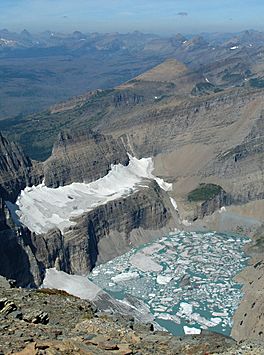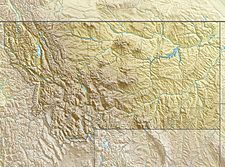The Salamander Glacier facts for kids
Quick facts for kids The Salamander Glacier |
|
|---|---|

The Salamander Glacier sits on a ledge above the greatly diminished Grinnell Glacier and the ice clogged Grinnell Lake in this 2009 image
|
|
| Type | Mountain glacier |
| Location | Glacier National Park, Glacier County, Montana, U.S. |
| Coordinates | 48°45′29″N 113°44′18″W / 48.75806°N 113.73833°W |
| Area | Approximately 42 acres (0.17 km2) in 2005 |
| Length | .10 mi (0.16 km) |
| Terminus | Rock ledge |
| Status | Retreating |
The Salamander Glacier is a cool ice formation located in Glacier National Park in the state of Montana, U.S. It sits high up on a rock ledge, like a shelf, on the east side of a sharp mountain ridge. This ridge is part of the Continental Divide, which is like a giant line of mountains that separates where water flows in North America. The glacier is about 7,200 feet (2,200 m) above sea level.
About The Salamander Glacier
A glacier is a huge mass of ice that moves very slowly over land. The Salamander Glacier is a mountain glacier, meaning it forms in high mountain areas. It's known for its unique position on a rocky shelf.
Where Is It Located?
You can find The Salamander Glacier in the beautiful Glacier National Park. This park is in Glacier County, Montana, in the United States. The glacier is nestled high in the mountains, making it a stunning sight for visitors. Its high elevation means it stays cold enough for ice to form and last.
How Big Is It?
The Salamander Glacier might not be the biggest glacier, but it's still impressive! In 1993, it covered an area of about 57 acres (0.23 km2). That's like having 57 football fields covered in ice! Even though it's only about .10 mi (0.16 km) long, it's quite wide, stretching about .75 mi (1.21 km) across.
Changing Over Time
Like many glaciers around the world, The Salamander Glacier has been getting smaller. This process is called "retreating." In 2005, its size was measured at about 42 acres (0.17 km2). This means it had shrunk by 23 percent since 1966.
A long time ago, before 1929, The Salamander Glacier was actually connected to a much larger glacier called Grinnell Glacier. But as Grinnell Glacier started to retreat, The Salamander Glacier became its own separate ice body. Scientists study these changes to understand how our planet's climate is changing.





